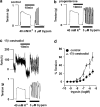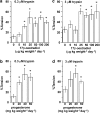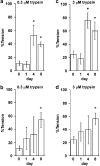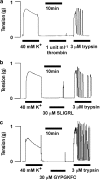Enhancement of trypsin-induced contraction by in vivo treatment with 17beta-estradiol and progesterone in rat myometrium
- PMID: 16056237
- PMCID: PMC1576290
- DOI: 10.1038/sj.bjp.0706345
Enhancement of trypsin-induced contraction by in vivo treatment with 17beta-estradiol and progesterone in rat myometrium
Abstract
We have previously reported that the contractile response to thrombin and trypsin was enhanced in the pregnant rat myometrium. We herein determined whether or not sex hormones contribute to this enhancement and the expression of protease-activated receptors (PARs). The nonpregnant rats received daily injections of either 17beta-estradiol or progesterone, and then the contractile response of the myometrium was examined ex vivo. Treatment with either 17beta-estradiol or progesterone had almost no significant enhancing effect on the high K(+)- or oxytocin-induced contraction. On the other hand, both 17beta-estradiol and progesterone dose-dependently enhanced the contractile response to trypsin. A maximal enhancement was obtained at 25 and 40 mg kg weight(-1) day(-1) for 17beta-estradiol and progesterone, respectively. The extent of the enhancement of the trypsin-induced contraction seen in the sex hormone-treated rats in the present study was comparable to that reported in the pregnant rats. However, the contractile response to thrombin and PAR1/PAR2-AP, SFLLRNP was not enhanced either by progesterone or 17beta-estradiol. PAR2-AP and PAR4-AP failed to induce contraction under any conditions. PAR1 mRNA was scarcely detected in the control myometrium by an RT-PCR analysis, while it slightly increased only in the progesterone-treated rats. Neither PAR2 nor PAR4 mRNA was detected. We thus conclude that the responsiveness to trypsin, but not thrombin, is controlled by sex hormones. A novel type of receptor, other than PAR1, PAR2 or PAR4, is suggested to mediate the trypsin-induced contraction as in the case of the pregnant rat myometrium.
Figures










Similar articles
-
Mechanism of trypsin-induced contraction in the rat myometrium: the possible involvement of a novel member of protease-activated receptor.Br J Pharmacol. 2001 Aug;133(8):1276-85. doi: 10.1038/sj.bjp.0704206. Br J Pharmacol. 2001. PMID: 11498513 Free PMC article.
-
Mechanisms of galanin-induced contraction in the rat myometrium.Br J Pharmacol. 1998 Aug;124(8):1623-32. doi: 10.1038/sj.bjp.0702004. Br J Pharmacol. 1998. PMID: 9756377 Free PMC article.
-
Progesterone decreases the relaxing effect of the beta3-adrenergic receptor agonist BRL 37344 in the pregnant rat myometrium.Reproduction. 2009 Aug;138(2):383-90. doi: 10.1530/REP-09-0116. Epub 2009 May 21. Reproduction. 2009. PMID: 19470710
-
Molecular Regulation of Parturition: A Myometrial Perspective.Cold Spring Harb Perspect Med. 2015 Sep 3;5(11):a023069. doi: 10.1101/cshperspect.a023069. Cold Spring Harb Perspect Med. 2015. PMID: 26337112 Free PMC article. Review.
-
[Modulation of uterine contractile activity by steroid sex hormones. Review].Ginecol Obstet Mex. 1997 Dec;65:498-503. Ginecol Obstet Mex. 1997. PMID: 9477643 Review. Spanish.
Cited by
-
Adverse effects of 4-tert-octylphenol on the production of oxytocin and hCG in pregnant rats.Lab Anim Res. 2014 Sep;30(3):123-30. doi: 10.5625/lar.2014.30.3.123. Epub 2014 Sep 29. Lab Anim Res. 2014. PMID: 25324873 Free PMC article.
-
Proteinase-activated receptors in the lower urinary tract.Naunyn Schmiedebergs Arch Pharmacol. 2007 Mar;375(1):1-9. doi: 10.1007/s00210-007-0139-9. Epub 2007 Feb 10. Naunyn Schmiedebergs Arch Pharmacol. 2007. PMID: 17294233 Review.
References
-
- AL-ANI B., SAIFEDDINE M., HOLLENBERG M.D. Detection of functional receptors for the proteinase-activated-receptor-2-activating polypeptide, SLIGRL-NH2, in rat vascular and gastric smooth muscle. Can. J. Physiol. Pharmacol. 1995;73:1203–1207. - PubMed
-
- COCKS T.M., FONG B., CHOW J.M., ANDERSON G.P., FRAUMAN A.G., GOLDIE R.G., HENRY P.J., CARR M.J., HAMILTON J.R., MOFFATT J.D. A protective role for protease-activated receptors in the airways. Nature. 1999a;398:156–160. - PubMed
-
- COCKS T.M., MOFFATT J.D. Protease-activated receptors: sentries for inflammation. Trends Pharmacol. Sci. 2000;21:103–108. - PubMed
-
- COCKS T.M., SOZZI V., MOFFATT J.D., SELEMIDIS S. Protease-activated receptors mediate apamin-sensitive relaxation of mouse and guinea pig gastrointestinal smooth muscle. Gastroenterology. 1999b;116:586–592. - PubMed
Publication types
MeSH terms
Substances
LinkOut - more resources
Full Text Sources
Miscellaneous

